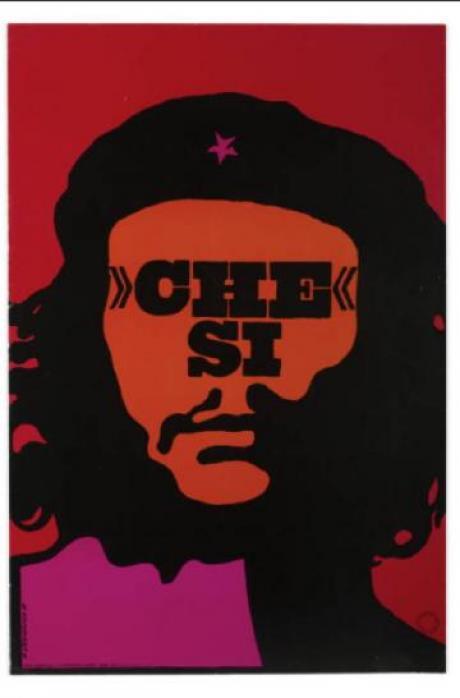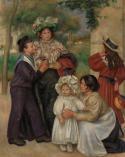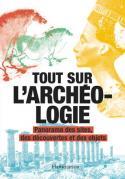Art Of The Day Weekly
#513 - from 3 May 2018 to 9 May 2018

Roman Cieslewicz, « Che » Si, Éditions Georges Fall, 1967. Poster, serigraphic © Adagp, Paris 2018 Photo: Paris, MAD Jean Tholance.
IN THE AIR
Cieslewicz, a graphic artist above all
PARIS – This unique Polish artist believed in un-polluting the eye, as he said. With his tool box in hand - including scissors, glue, pencils, photographs – he was constantly in action and set the level of special effects very high for the digital era. Roman Cieslewicz (1930-1996) operated before, and that is a good thing, as we can see in his creations all the poetry of crafts, volume, what is manual. He was an insatiable graphic artist as is proven by the 700 different pieces presented in this exhibition, and excelled in making posters just like his compatriots, but not only. He also made covers for books, and magazines, worked in advertising, in fashion (it was Peter Knapp, the famous talent scout, who recruited him for the magazine Elle); in political satire (at Kamikaze, ad with his buddies, among them Topor, from the group Panique. Cieslewicz loved to archive, and kept all his press cutouts in hundreds of boxes –like Hergé-, an essential element in this exhibition.
• Roman Cieslewicz, la fabrique des images at the Musée des arts décoratifs (MAD), from 3 May to 23 September 2018.
Photo and painting race one another towards abstraction
LONDON – Usually, when painting and photography are confronted to one another, it is to show how the latter has replaced, or stimulated the former, in the figurative world. This rivalry has sometimes been expressed in the other way, when so-called ‘pictorial’ photographers made it their goal to imitate painting. Strangely enough, interactions were much less studied regarding abstraction. Are abstract painting and abstract photography linked to one another? The exhibition at the Tate seems to prove it, by presenting interesting confrontations, while pulling valid artists out from their anonymity. It is the case between Braque’s Cubist paintings and Pierre Dubreuil’s photographs; between Pollock’s drippings and Steinert’s “luminograms”; or between Bridget Riley’s Op Art and Floris Neusüss’s photograms.
• Shape of Light: 100 Years of Photography and Abstract Art, at the Tate Modern, from 2 May to 14 October 2018.

Pierre-Auguste Renoir, The Artist's Family, 1896. Oil on canvas. 68 1/8 x 54 in. (173 x 137.2 cm). BF819. © 2017 The Barnes Foundation
Renoir father and son
PHILADELPHIA – It can happen sometimes that a father and son shine with the same intensity in disciplines that are close or different: as examples we have the Rostand (Edmond and Jean), or the Douglas (Kirk and Michael). The case of the Renoir is quite unique though, since the father (Pierre-Auguste, 1841-1919) was one of the founders of Impressionism and his son (Jean, 1894-1979) was the “greatest movie director of the 19th century” according to Orson Welles in his necrology. A confrontation between the two has been tried many times before, in particular in 2005 at the Cinémathèque in Paris. The strength of the Barnes Foundation is of course to own the largest collection in the world of works by Renoir Sr. – exactly 181! The ambivalent relationship – admiration as well as rejection – is explored with confrontations between works (canvases and extracts of movies), as well as the presentation of Jean’s notebooks and, a lesser-known aspect, with his other artistic trials. When he was young, in a sort of wish to emulate, he tried to find his path in ceramics (one of his brothers, Claude, excelled in that field as well). Dr. Barnes, who was curious and watchful of all expressions, had bought some twenty potteries by this promising but unknown artist.
• Renoir: Father and Son/Painting and Cinema, at the Barnes Foundation, from 6 May to 3 September 2018.
BOOKS
Archeology on the program
In a world that is constantly moving, increasingly living to a staccato rhythm, we all need points of reference. Mementos, compendiums and other address books have always existed and now present a new breed. It can be looked at in 3 minutes (this is the title of a collection), or when more rested, there is enough here to build a culture by proxy – without reading the original works or visiting the sites. In this field, we would take irony, or originality in the classification (Phaidon recently published quite an interesting retro-story of art), or clarity. This book on a difficult discipline (archeology) can be classified in the last category. The few thousand years of our history are sifted through chronologically at a good pace. For each of the five large periods (until 1600, even if we know we can do archeology on the site where the movie Peau d’âne was shot!), a map announces the fifty sites that will soon be summed up in two pages, combining description, biographies, and a large map. Babylonia and Teotihuacán are among them, as well as lesser-known sites and moments such as Caral in Peru or the siege of Lakish by the Assyrians. Pick away, something will always remain!
• Tout sur l’archéologie, collective work directed by Paul Bahn, Flammarion, 2018, 576 p., €35.
9782081421530


